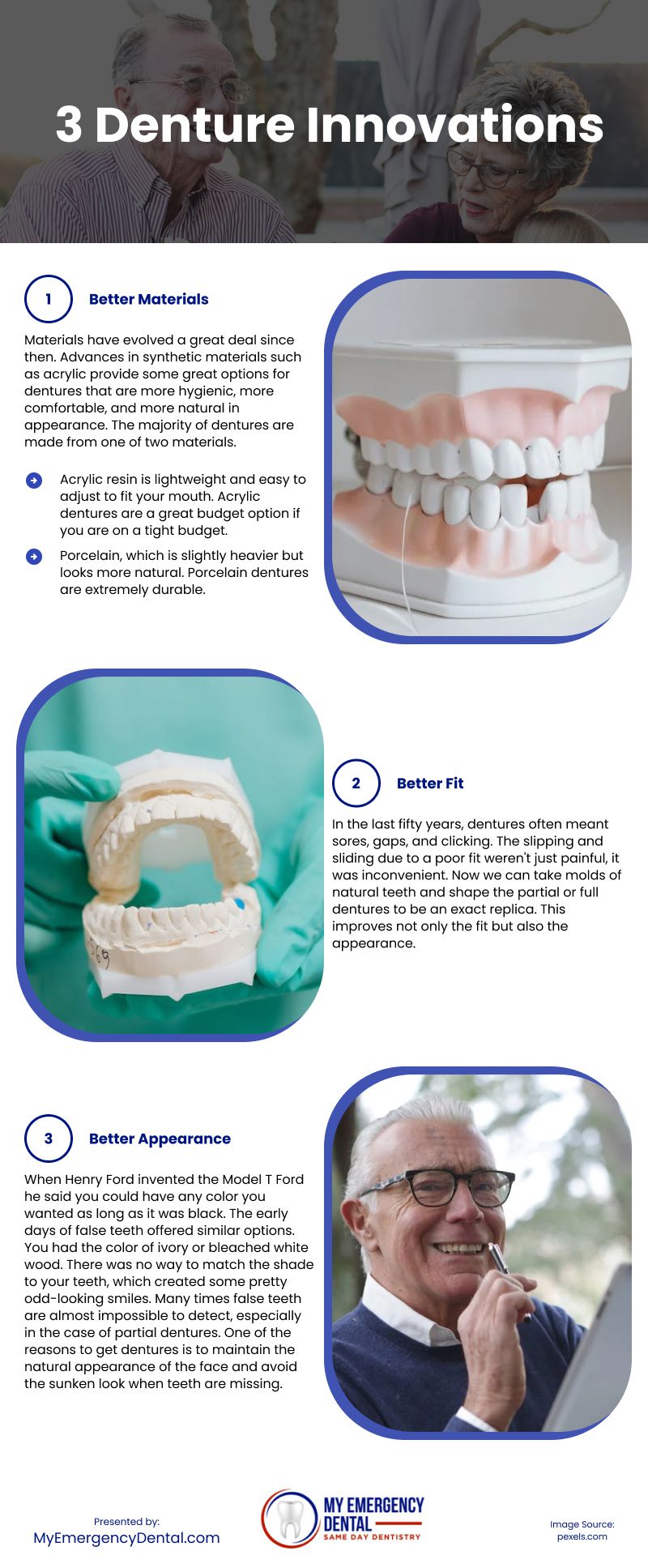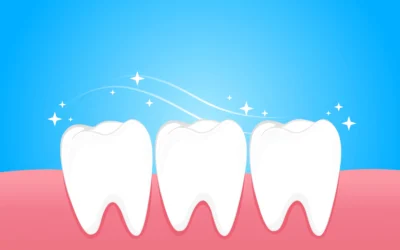While we pledge allegiance to the flag and honor George Washington’s courage and honesty, none of us would want his teeth. Stories abound about the poor general’s wooden teeth, ivory teeth, or even human teeth of questionable origin. The truth is that there were several sets of teeth and not a single pair was comfortable.
Luckily, modern comforts apply to more than just indoor plumbing and air conditioning. Dentures have also improved in incredible ways, even in the last few decades. The dentures of today barely resemble the clunky and painful false teeth of generations past.
Better Materials
Archaeologists have found evidence of false teeth in the tombs of the ancient Egyptians. They consisted of a mix of human and animal teeth tied together with gold thread or wire. Sounds comfortable, right? They were probably merely for appearance, as it seems like it would be impossible to enjoy a meal with that sort of mess in your mouth.
Materials have evolved a great deal since then. Advances in synthetic materials such as acrylic provide some great options for dentures that are more hygienic, more comfortable, and more natural in appearance. The majority of dentures are made from one of two materials.
- Acrylic resin, which is lightweight and easy to adjust to fit your mouth. Acrylic dentures are a great budget option if you are on a tight budget.
- Porcelain, which is slightly heavier but looks more natural. Porcelain dentures are extremely durable.
While some cultures experimented with wood or ivory from the tusks of elephants or hippos. George Washington was known to sport a set of hippo tusk teeth as well as some wooden models. You don’t need to worry about where your new teeth came from. They can be made to look exactly like your old ones.
Better Fit
Limited tools meant that a good fit was a challenge. In even the last fifty years, dentures often meant sores, gaps, and clicking. Dentures that could not be securely attached and sealed in the mouth meant moving parts and sores on the gums and cheeks.
The slipping and sliding due to a poor fit weren’t just painful, it was inconvenient. It affects speech, eating, and smiling. Since we do those things every day, then poorly fitting dentures would be a real nuisance.
Luckily, better materials and tools have created a better fit. We have improved measuring and scanning devices that make it easier to get an exact fit. Now we can take molds of natural teeth and shape the partial or full dentures to be an exact replica, improving not only the fit but also the appearance.
Better Appearance
When Henry Ford invented the Model T Ford he said you could have any color you wanted. . . as long as it was black. The early days of false teeth offered similar options. You had the color of ivory or bleached white wood. There was no way to match the shade to your teeth, which probably created some pretty odd-looking smiles.
Technology, even in the last few decades, has made huge leaps in matching natural tooth colors and shapes. Many times false teeth are almost impossible to detect, especially in the case of partial dentures. One of the reasons to get dentures is to maintain the natural appearance of the face and avoid the sunken look when teeth are missing.
Some Things Never Change
While materials, fit, and appearance have changed, the need to care for false teeth hasn’t changed much. Just because the teeth aren’t real, doesn’t mean they don’t need care. Having the perfect fit and color will only last if you take some steps to care for them.
Keep Brushing and Rinsing
If you have a mixture of false teeth and real teeth, those real teeth still need to be brushed twice a day, with attention to your gums and tongue. The fit of your dentures is affected by the health of your gums so take care to keep that gumline clean. Flossing is a great way to keep gums healthy. Mouthwash is also a great idea to maintain your teeth, natural or not. Drinking plenty of water will help rinse away food particles between meals and keep everything clean.
As for brushing your dentures, use an extra-soft toothbrush or one specifically designed for dentures. There are also denture cleaners that will do a great job. Do not use regular toothpaste as it can be abrasive and wear down the porcelain on false teeth.
After you brush, give it a rinse.
Keep it Cool and Don’t Dry Out
Hot water might help your whites stay bright, but it isn’t a good idea for dentures. Hot water can soften and reshape your dentures, leading to poor fit and discomfort. After brushing, rinse with mildly warm water, then soak in room temperature water.
Soaking is an important step. Dry dentures are not happy dentures. Dryness can create opportunities for cracking, which will ruin that carefully designed fit. As soon as you’ve cleaned them, plop them in a cup of water.
And Yes, You Still Have to Go to the Dentist
While the stickers and free toothbrush might not be enough motivation at this stage of life, those dentist visits are important, even if your teeth were built in a lab and not grown in your mouth. The dentist keeps an eye on the overall health of your mouth, checking for any problems with your gums or tongue.
They also have a trained eye that will notice gaps or movement that you might not notice on a day-to-day basis. Spotting a gap early can keep away more serious problems down the road. Do you know the saying about an ounce of prevention and a pound of cure? Regular checkups with the dentist prove the truth of that maxim! So, if it has been a while, stop now and get that dentist appointment!
Dentures are nothing to fear these days. Trying to eat a cheeseburger with a mouth full of gold wire and wooden teeth sounds pretty awful, but with improved materials, fit, and appearance, you can happily renew that smile with confidence.
Infographic
Even though we swear allegiance to the flag and admire George Washington’s courage and morality, nobody would want his teeth. There are quite a few tales that destitute general’s teeth are made of human, ivory, or even wood. Mercifully, modern comforts extend to today’s dentures, which are so much more comfortable than the unpleasant dentures of the past.

Video




